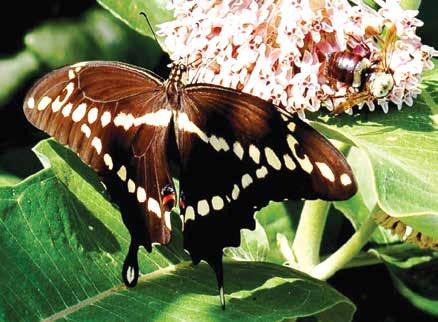Photo by Scott Woodbury.
Photo by Scott Woodbury.
Photo by Carol Davit.
Above: Wild Sweet William; Below: Sand Phlox Left: Garden Phlox with snow on the mountain
A
romas forge strong memories. Take my first encounter with a fragrant native plant—garden phlox. When I was in high school, an older friend showed me her garden. To this day I remember the details. Walking down the sidewalk, approaching masses of pink and white flowers growing along a picket fence, generating distinctive sweet summer smells. The fragrance was so intoxicating that I think of that fortyyear-old memory every summer when phlox is in bloom. Garden phlox (Phlox paniculata) cultivars are prolific and common in garden centers. But the native straight species is not. Unfortunately, the world of horticulture has overlooked one of nature’s greatest gifts. As a straight species, this phlox is reasonably powdery mildew free, as opposed to the many cultivars that perform
Irresistible Phlox
so poorly in the humid lower Midwest. (Yogi Berra said it best, “It ain’t the heat, it’s the humility.”) Garden phlox grows in part shade to full sun, in poorly drained moist soils, or in well-drained dry areas in the garden. Its greatest strength is in its ability to colonize strongly on difficultto-mow shady slopes and compliment other strong-performing species like creek oats (Chasmanthium latifolia), smoothcone sedge (Carex laeviconica), rough goldenrod (Solidago rugosa), false sunflower (Heliopsis helianthoides), woodland knotweed (Persicaria virginiana), curlytop ironweed (Vernonia arkansana), yellow wingstem (Verbesina helianthoides), obedient plant (Phyostegia virginiana), and Joe Pye weed (Eutrochium purpureum). It has the
SCOTT WOODBURY Horticulturist 22
May 2021 | kcgmag.com
potential to spread from seed and underground rhizomes. Individual seedlings may be clump forming or suckering, so we look for clump formers (we have a large patch with hundreds of seedlings in the upper woods) and transplant them to the more formal section of the garden. Because birds don’t eat many (or any) of the seeds, we deadhead plants growing in the garden when they are finished blooming. Though each phlox species varies widely in vigor, soil, and sunlight requirements, they have one thing in common. They are all pleasant on the nose. Wild sweet William (Phlox divaricata) is a species with an allure like the sirens from Homer’s ancient Odyssey— so beautiful, yet so dangerous. The scent of the light blue flowers in April is irresistibly sweet. On a
scale of aggression (1 being nonaggressive, 10 being most aggressive) wild sweet William scores a 2, compared to the suckering form of garden phlox, which scores an 8 (clump-forming garden phlox is a 5). I’ve never seen too much wild sweet William in a garden, because they prefer well-drained soils in the shade, and many of our garden soils are heavy clay, with less-than-perfect drainage. My favorite companion plants include yellow honeysuckle (Lonicera flava), flowering dogwood (Cornus florida), roundleaved groundsel (Packera aurea), wild columbine (Aquilegia canadensis), sweet Cicely (Osmorhiza claytonia), and celandine poppy (Stylophorum diphyllum). Sand phlox (Phlox bifida) blooms in March and April, with light blue flowers (or lavender) and gold stamens. It doesn’t need sandy soil to grow well, but it does prefer
Horticulturist Scott Woodbury is the Curator of the Whitmire Wildflower Garden at Shaw Nature Reserve in Gray Summit, MO, where he has worked with native plant propagation, design, and education for 30 years. He also is an advisor to the Missouri Prairie Foundation’s Grow Native! program. Find suppliers of native plants and seeds at www.grownative.org, Resource Guide.













